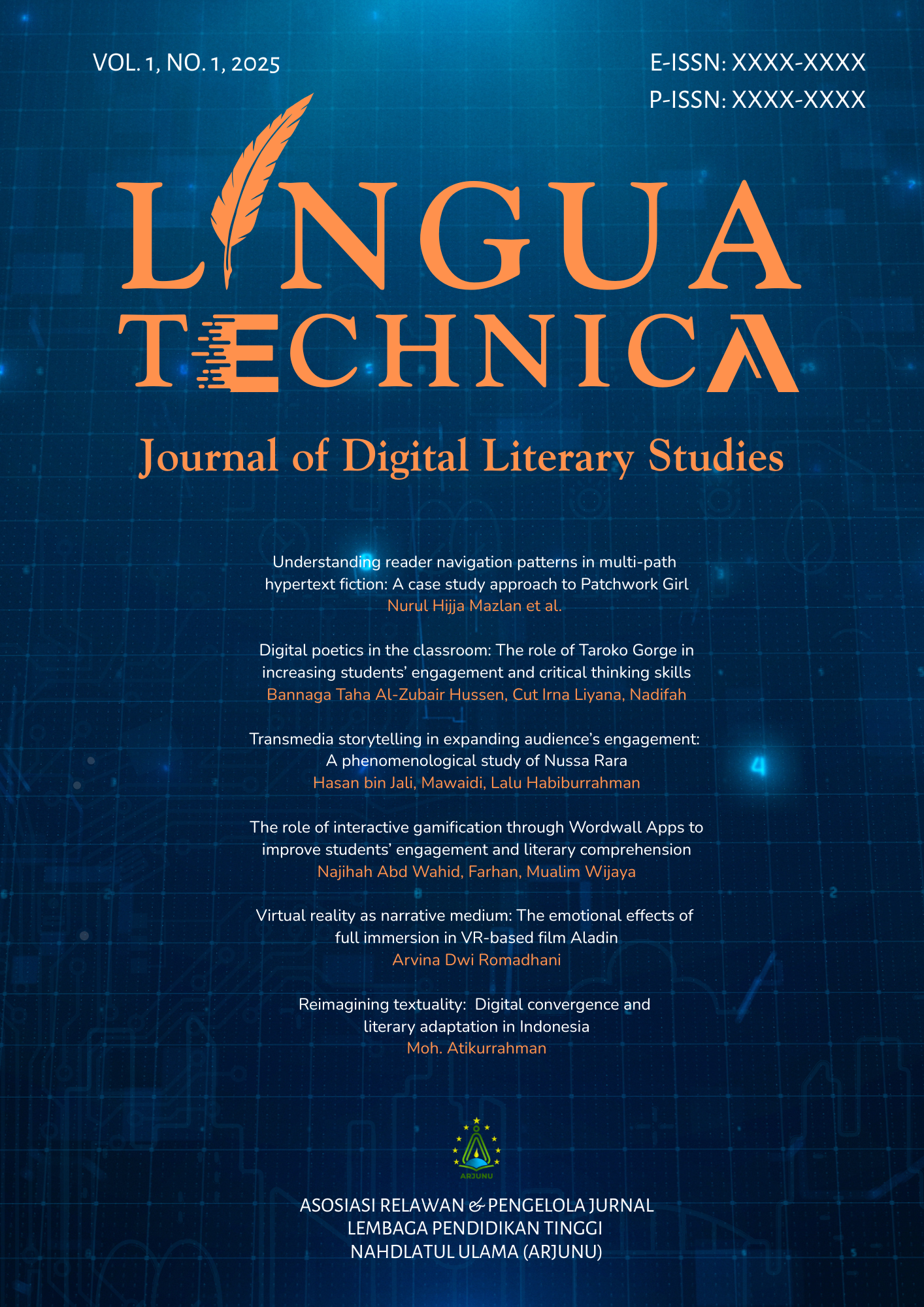Reimagining textuality: Digital convergence and literary adaptation in Indonesia
DOI:
https://doi.org/10.64595/lingtech.v1i1.30Keywords:
Indonesian literature, multimodality, cyberculture, adaptation, convergence mediaAbstract
This article explores the multimodal circulation of Indonesian literary texts through television and digital adaptations, focusing on their implications for the conceptualization and cultural valuation of literature in the digital age. The technological boom and evolving reading practices have shaped how literature is disseminated, especially through intersemiotic media platforms. Drawing on theories of cyberculture and media convergence (David Bell dan Tim Dwyer), this study analyzes examples such as the adaptation of Laskar Pelangi by Andrea Hirata into film and television, Bumi Manusia by Pramoedya Ananta Toer into cinema, and Tenggelamnya Kapal Van Der Wijck by Hamka into both screen and digital fandoms. These cases reveal a cultural ecosystem in which television, internet platforms, and user-generated content converge to sustain literary texts and cultivate new modes of engagement. The shift from print-centered authority to interactive and collaborative reinterpretation challenges traditional notions of originality and authorship while expanding access to literature across social strata.
Downloads
References
Aliagas, C., Correro, C., & Fittipaldi, M. (2024). Digital Fiction in Literary Education: What do secondary-school teachers think about this multimodal artform as a pedagogical resource? L1-Educational Studies in Language and Literature, 24(3), 1–27. https://doi.org/10.21248/l1esll.2024.24.3.594
Aung, N., Dhelim, S., Chen, L., Ning, H., Atzori, L., & Kechadi, T. (2023). Edge-enabled metaverse: The convergence of metaverse and mobile edge computing. Tsinghua Science and Technology, 29(3), 795–805. https://doi.org/10.26599/TST.2023.9010052
Bell, D. (2006). An introduction to cybercultures. Routledge. https://doi.org/10.4324/9780203192320
Coiro, J. (2021). Toward a multifaceted heuristic of digital reading to inform assessment, research, practice, and policy. Reading Research Quarterly, 56(1), 9–31. https://doi.org/10.1002/rrq.302
Dwyer, T. (2010). Media convergence. McGraw-Hill Education (UK). https://archive.org/details/mediaconvergence0000dwye
Fahey, E. (2024). The evolution of EU–US cybersecurity law and policy: On drivers of convergence. Journal of European Integration, 46(7), 1073–1088. https://doi.org/10.1080/07036337.2024.2411240
Fischer, D., Reinermann, J.-L., Mandujano, G. G., DesRoches, C. T., Diddi, S., & Vergragt, P. J. (2021). Sustainable consumption communication: A review of an emerging field of research. Journal of Cleaner Production, 300, 126880. https://doi.org/10.1016/j.jclepro.2021.126880
Fontes, C., Carpentras, D., & Mahajan, S. (2024). Human digital twins unlocking Society 5.0? Approaches, emerging risks and disruptions. Ethics and Information Technology, 26(3), 54. https://doi.org/10.1007/s10676-024-09787-1
Garibaldi, S., & Deane, F. (2023). Cyberspace as a fifth dimension of national security: Trade measure exceptions. Journal of International Trade Law and Policy, 22(2), 67–88. https://doi.org/10.1108/JITLP-01-2023-0004
Gundersen, O. E. (2021). The fundamental principles of reproducibility. Philosophical Transactions of the Royal Society A, 379(2197), 20200210. https://doi.org/10.1098/rsta.2020.0210
Haig, Z. (2021). Relationships between cyberspace operations and information operations. Advances in Military Technology, 16(1), 91–105. https://doi.org/10.3849/aimt.01466
Hamka, H. (2013). Tenggelamnya Kapal Van Der Wijck. Balai Pustaka. https://archive.org/details/TenggelamnyaKapalVanDerWijck_201801
Hirata, A. (2008). Laskar Pelangi. Bentang. https://archive.org/details/AndreaHirataLaskarPelangi_201805
Hwang, S.-Y., Shin, D.-J., & Kim, J.-J. (2022). Systematic review on identification and prediction of deep learning-based cyber security technology and convergence fields. Symmetry, 14(4), 683. https://doi.org/10.3390/sym14040683
Kersting, M., Danielsson, K., Fleury Mortimer, E., Olander, C., Siry, C., & Tang, K.-S. (2024). From founding voices to future visions: Languages and literacies in science education. International Journal of Science Education, 1–18. https://doi.org/10.1080/09500693.2024.2377424
Klarer, M. (2023). An introduction to literary studies. Routledge. https://doi.org/10.4324/9781003133025
Kress, G., & Bezemer, J. (2023). Multimodal discourse analysis. In The Routledge handbook of discourse analysis (pp. 139–155). Routledge. https://doi.org/10.4324/9781003035244-12
Ning, H., Lin, Y., Wang, W., Wang, H., Shi, F., Zhang, X., & Daneshmand, M. (2022). Cyberology: Cyber–physical–social-thinking spaces-based discipline and interdiscipline hierarchy for metaverse (general cyberspace). IEEE Internet of Things Journal, 10(5), 4420–4430. https://doi.org/10.1109/JIOT.2022.3217821
Osula, A.-M., Kasper, A., & Kajander, A. (2022). EU common position on international law and cyberspace. Masaryk University Journal of Law and Technology, 16(1), 89–123. https://doi.org/10.5817/MUJLT2022-1-4
Otor, S. U., Akinyemi, B. O., Aladesanmi, T. A., Aderounmu, G. A., & Kamagaté, B. (2021). An improved bio-inspired based intrusion detection model for a cyberspace. Cogent Engineering, 8(1), 1859667. https://doi.org/10.1080/23311916.2020.1859667
Pereira, Í. S. P., Gil, M., & Sylla, C. M. (2023). Meeting the challenges of designing multimodal texts to promote multiliteracies pedagogy. Comunicação e Sociedade, 43, e023008. https://doi.org/10.17231/comsoc.43(2023).4481
Song, L., Hu, X., Zhang, G., Spachos, P., Plataniotis, K. N., & Wu, H. (2022). Networking systems of AI: On the convergence of computing and communications. IEEE Internet of Things Journal, 9(20), 20352–20381. https://doi.org/10.1109/JIOT.2022.3172270
Toer, P. A. (2005). Bumi Manusia. Lentera Dipantara.
Wang, C. (2024). Exploring Students’ Generative AI-Assisted Writing Processes: Perceptions and Experiences from Native and Nonnative English Speakers. Technology, Knowledge and Learning. https://doi.org/10.1007/s10758-024-09744-3
Weiss, M., & Biermann, F. (2023). Cyberspace and the protection of critical national infrastructure. Journal of Economic Policy Reform, 26(3), 250–267. https://doi.org/10.1080/17487870.2021.1905530
Wu, J. (2022). Cyberspace endogenous safety and security. Engineering, 15, 179–185. https://doi.org/10.1016/j.eng.2021.05.015
Zhao, C., Dai, X., Lv, Y., Tian, Y., Ren, Y., & Wang, F.-Y. (2023). Foundation models for transportation intelligence: ITS convergence in TransVerse. IEEE Intelligent Systems, 37(6), 77–82. https://doi.org/10.1109/MIS.2022.3221342
Zhou, Y., Tiwari, M., Bernot, A., & Lin, K. (2024). Metacrime and cybercrime: Exploring the convergence and divergence in digital criminality. Asian Journal of Criminology, 19(3), 419–439. https://doi.org/10.1007/s11417-024-09436-y
Zhu, Y., Kwon, M., & Zhao, Y. (2022). A Study on Visual Perception Differences between Hot Media and Cool Media Focusing on Image News and Text News Reading. Sch J Eng Tech, 9, 235–244. https://doi.org/10.36347/sjet.2022.v10i09.002
Zwitter, A. (2024). Cybernetic governance: Implications of technology convergence on governance convergence. Ethics and Information Technology, 26(2), 24. https://doi.org/10.1007/s10676-024-09763-9
Downloads
Published
How to Cite
Issue
Section
License
Copyright (c) 2025 Moh Atikurrahman

This work is licensed under a Creative Commons Attribution-ShareAlike 4.0 International License.






























 Creative Commons Attribution 4.0 International License
Creative Commons Attribution 4.0 International License